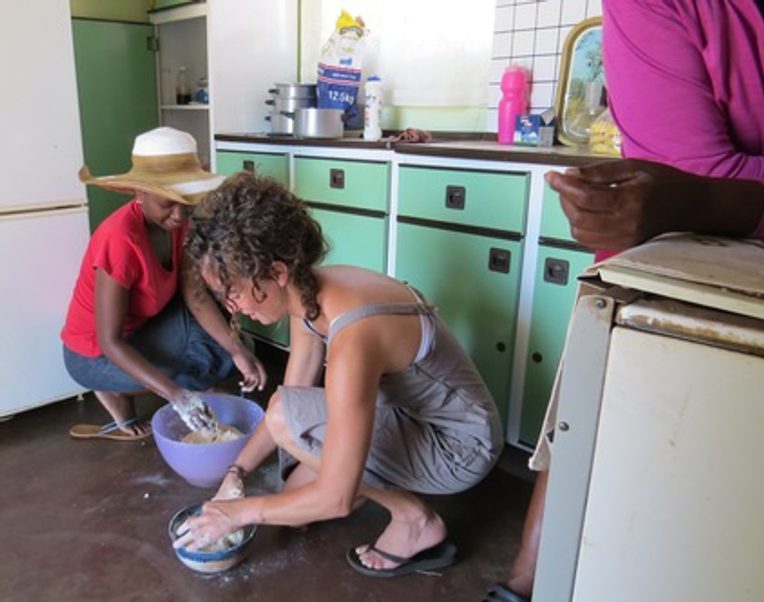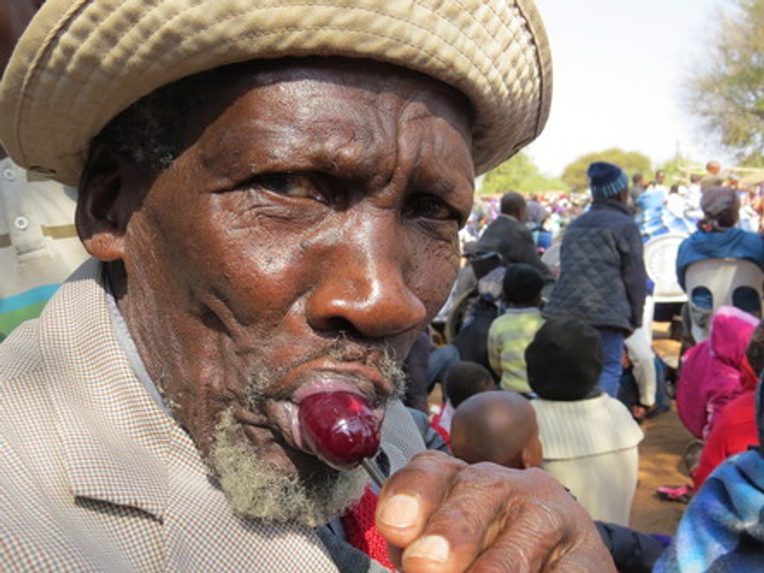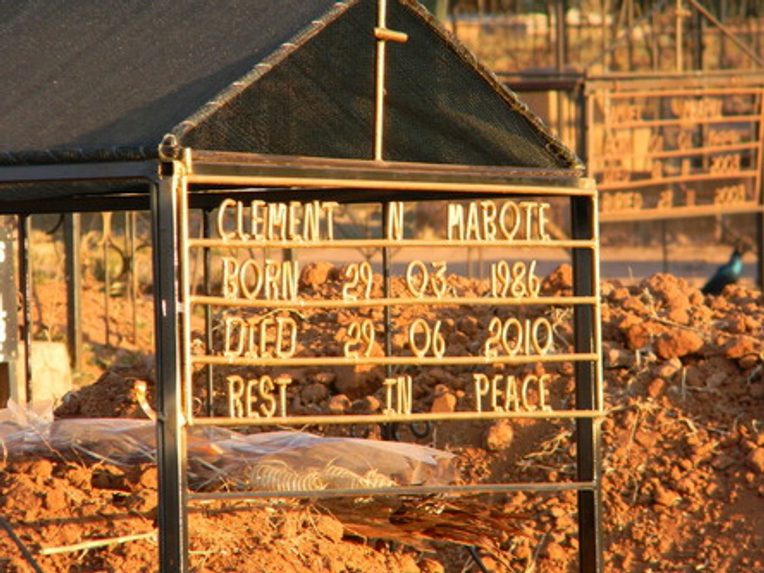This post builds on the research article ““Too Fat to Be an Orphan”: The Moral Semiotics of Food Aid in Botswana,” which was published in the November 2014 issue of the Society’s peer-reviewed journal, Cultural Anthropology.

Editorial Footnotes
Cultural Anthropology has published a number of articles on humanitarianism, including Tobias Rees’s “Humanity/Plan; or, On the ‘Stateless’ Today (Also Being an Anthropology of Global Health)” (2014); Kevin Lewis O’Neill’s “Left Behind: Security, Salvation, and the Subject of Prevention” (2013); and Ilana Feldman’s “Difficult Distinctions: Refugee Law, Humanitarian Practice, and the Identification of People in Gaza” (2007).
Cultural Anthropology has also published articles and resources on children and youth, including Jocelyn Lim Chua’s “Making Time for the Children: Self-Temporalization and the Cultivation of the Antisuicidal Subject in South India” (2011); Donna Perry’s “Fathers, Sons, and the State: Discipline and Punishment in a Wolof Hinterland” (2009); and the curated collection, “Youth,” curated by Elizabeth Lewis.
About the Author
Bianca Dahl is an assistant professor of anthropology at the University of Toronto. She received her PhD in comparative human development from the University of Chicago. Dahl’s book manuscript on humanitarian interventions targeting orphaned children—tentatively entitled Great Expectations: Aid, AIDS, and the Invention of Orphans in Botswana—received the 2012 Social Science Research Council Book Development Award. Dahl’s recent research includes work on changing forms of social stigma experienced by children living with HIV and a new project on sexuality that delves into the cultural politics of campaigns to circumcise men as a prophylactic measure against the spread of HIV.

Other Works by the Author
2012. “Beyond the Blame Paradigm: Rethinking Witchcraft Gossip and Stigma around HIV-Positive Children in Southeastern Botswana.” African Historical Review 44, no. 1: 53–79.
2009. “The ‘Failures of Culture’: Christianity, Kinship, and Moral Discourses about Orphans during Botswana’s AIDS Crisis.” Africa Today 56, no. 1: 23–43.
Interview with Bianca Dahl
Jessica Lockrem: How did you become interested in orphans and aid programs?
Bianca Dahl: In 2002, I read a news article about two residential orphanages in Ethiopia. One was for children who were HIV-negative, who were essentially being readied for adoption to the United States: taught to eat with knives and forks, use flush toilets, speak English, etc. The other was for children who were HIV-positive and therefore not deemed adoptable; yet in what the journalist praised as a humanitarian gesture, this charity was essentially raising them the same way as the HIV-negative kids, as if they were to be adopted overseas. However, instead of departing to meet their new American families, many of these kids quietly died—even as the fiction of readying them for adoption was rigorously maintained in the NGO’s daily practices. I was fascinated and in no small degree disturbed by how this organization posited spaghetti-eating-techniques and Midwestern table manners as a fundamental human right and a self-evident good. This was what first prompted me to reflect on a host of broader questions about how children are being raised in the midst of the AIDS epidemic, of which foreign aid organizations are merely one part.
JL: How did you become interested in these issues in Botswana?
BD: HIV in Africa is epidemiologically unusual in terms of pandemics, in that the virus disproportionately targets adults in their prime reproductive years rather than the very young and very old, like most epidemic diseases. I decided to go to Botswana in 2003 because at the time it had the highest prevalence worldwide—38.8 percent of adults were estimated to have HIV or AIDS. It seemed like an appropriate place to try to understand how high rates of adult death affected the children “left behind.” Things have changed a lot since then; now, with free antiretroviral drugs available nationwide, Tswana people no longer view AIDS as the death sentence it once seemed to be. But HIV continues to be symbolically, economically, and politically transformative. And, in a fundamental way, the epidemic led to an opening of Botswana’s borders to a variety of aid programs that continue to have lasting effects. My focus was on humanitarian interventions for orphans. I’ve tried to understand the ways in which young people appropriated and reworked the incentive structures to perform particular types of victimization that would be legible to a foreign donor audience.
JL: Were there any particular challenges (or joys) working with children during your fieldwork?
BD: You know, many scholars in the anthropology of childhood claim nobody wants to do ethnographic research with kids because they are perceived in mainstream anthropology as being harder or less interesting to talk to, because the ethics are more complicated, because you can’t necessarily “trust” their responses. I am not at all convinced that children are inherently challenging. On the contrary, young people can be the best research subjects—not just because they’ll happily tell a bumbling anthropologist to her face whenever she does anything wrong, but also because their sophisticated maneuvering around the moral codes they face in their lives can be riveting. Don’t get me wrong: I’ve been witness to (and in some scenarios been entangled in the response to) some horrible situations that young people have endured, and matters like sexual assault are especially abhorrent when their targets are juveniles. Yet my work with orphans has also been characterized by nonstop hilarity, laughter, creativity, teasing, and fun. This article starts with an anecdote about a girl being accused of out-girthing her orphan status, and that ethnographic moment—a moment of pure, unadulterated, collective mirth—is just a small taste of the good humor of kids and adults in Botswana. So while my critiques of aid are serious, and the issue of how to raise orphans is a matter of great concern and contention for Tswana people, I nonetheless have no reticence in saying I truly loved conducting this fieldwork.

JL: The article focuses mainly on the orphans’ and the community’s reactions to the aid program. Did you also do fieldwork among the aid workers? Were they also concerned about the changing behaviors of the children? Did they interpret the orphans’ bodies as fat(ter)? If so, how did they interpret this fatness?
BD: Fatness never really came up with the aidworkers. Honestly, it took a long time before I myself was fully aware of how important idioms of fatness had become. It was only in a conversation post-field with a fellow anthropologist that I came to realize the systematic significance of bodily descriptions in the accounts villagers made of orphans’ behaviors. In the article, I’ve had to flatten the engagements of aidworkers somewhat into a generalized account, but many of them were deeply critical of the organization and its effects, even while some of those same individuals were also unwittingly responsible for the perpetuation of problematic practices at the center. To be fair, I can’t say how many times I also “messed up” in my engagements with the kids—it’s hard work to shed your cultural baggage, and I’ve too often been guilty of failing to do so myself. The aidworkers’ missteps were in so many ways structurally conditioned. My goal here is not to demonize well-intentioned volunteers: I am convinced the root issue around the villagers’ complaints that I document in this article lies in the ways the foreign-funded NGOs (and, differently, Botswana’s national social services system) target their interventions toward the population of orphaned children, and misread the forms of care-giving that undergird familial responses to orphaning.

JL: You conducted fieldwork over a period of about nine years, and have been in contact with these same children for more than a decade. In that time, did you see children become no longer eligible for the aid program because they were too old? How did the children adjust to losing the food, excursions, and gifts they were accustomed to receiving?
BD: Although I don’t discuss it in the article, the organization this research is based upon was shut down by both the government and its trustees in the mid-2000s. I delve into this closure and its effects on the children in detail in my book manuscript, but ultimately decided not to introduce it into the analysis here. Suffice to say, yes: the loss of support had lasting effects. Recently (seven years after the closure of the center), I was chatting with a young woman who’d been one of its beneficiaries, and she mused, quite poignantly I thought, “Today, I can’t say whether I ultimately benefited more or suffered more because of this place. It has both helped and harmed me so much.” For some of the orphans, the closure of the NGO incentivized them to repair any ruptures with their family members. For others, though, this proved extremely difficult, even impossible. The damage to kinship relationships was for many young people real, and has continued to impact their lives negatively.
JL: I’m curious how you think your subjectivity affected how the children and the community related to you. Did they at first assume you were an aidworker? You mention that some were wary of the influence of the West on their children; were they also wary of you interacting with the children at first?
BD: Initially, that’s exactly what they assumed: that I was just another volunteer at Bathusi. Informed consent is a continual and ongoing process, and I’ve regularly reminded people of my role as an anthropologist. But it’s a complex scenario, and I’m aware that my job description doesn’t necessarily make a whole lot of sense in the local context. I certainly integrated myself far more into the village than the volunteers did, and a key difference in my relationships is that I have continued to come back year after year, and I have forged lasting friendships with the former staff members at Bathusi as well as with many villagers. I also speak fairly decent Setswana. I think some members of the community may still view me in association with the organization, but it’s been years since its closure. Whatever perspective villagers have had on my purpose in Botswana has certainly not prevented them from articulating to me quite forceful complaints about foreigners! I hope that my sympathy for their concerns, and the fact that I listen to their complaints, has allowed for a kind of alliance.
JL: How does the subject of this article relate to your other work? What will you be working on next?
BD: After the project on orphans that is the basis of this article and my book manuscript, I conducted research on HIV-positive children in rural areas. I traced the changing forms of stigma they and their families experience in the wake of public health prevention successes. That research was very difficult for me to do, for reasons of access as well as my own entanglements in the topic. I’ve since moved on to a new project about romance, sexuality, flirtation, and creative new discourses and practices around HIV prevention. This is unfolding at a historical moment when antiretroviral drugs have transformed the epidemiological landscape and paved the way for reinventions of sexual intimacy and risk. I’m particularly interested in how male circumcision is being promoted in Botswana for its preventative effects against the spread of HIV at a population level. This has led to a remarkable array of political responses from tribal chiefs, and unexpected reactions on the part of both men and women (who, I am finding, are beginning to articulate surprisingly different gendered strategies around HIV-prevention in their romantic relationships). This is all in the early stages, but I’m intrigued by the cultural politics of sex and circumcision in the context of Botswana’s renowned successes at the treatment of HIV/AIDS.

Questions for Classroom Discussion
- What does the author mean by moral semiotics? What is it about the “semiotic signaling occasioned by children’s bodies” (3) that is specifically moral in nature?
- Dahl writes that “although resource provision and feeding form a fundamental part of caregiving, the exchange of food and other necessities is supposed to stand for a more selfless, loving, mutually respectful relationship in Tswana morality” (13). While this article argues that foreign aid organizations misunderstood the relationship between food and care in Botswana, it also shows how local discontent was produced by the government’s provision of resources to orphans’ families. In what ways did the government’s food basket program, which gave food to children’s guardians rather than just orphans, also undercut the logic of kinship, food, and care?
- Despite a great deal of local gossip about how orphans were becoming overfed, Dahl indicates that she did not notice any significant changes in the young people’s actual body sizes or shapes—that they were not appreciably fatter than their non-orphaned peers. Does this observation affect the article’s overall argument about the importance of reading bodies? Why or why not?
- The author notes several ethnographic examples of young people appropriating, playing with, and otherwise responding to discourses about their fatness or entitlement. To what extent did the orphans seem self-aware of their status change? Would you characterize their actions as an expression of resistance or agency?
- Why did critiques seem to coalesce around fatness in particular? What is it about food that seems so contentious in this context?
- How do you think Western cultural understandings of orphanhood shared by the foreign aidworkers at Bathusi may have contributed to the dynamics that arose around orphans’ entitlement? Do you think stereotypes about Africa may also have contributed to the forms of aid that were provided?


Related Readings
Bornstein, Erica. 2001. “Child Sponsorship, Evangelism, and Belonging in the Work of World Vision Zimbabwe.” American Ethnologist 28, no. 3: 595–622.
Cole, Jennifer, and Deborah Durham, eds. 2008. Figuring the Future: Globalization and the Temporalities of Children and Youth. Santa Fe, N.M.: School for Advanced Research Press.
Comaroff, Jean. 2007. “Beyond Bare Life: AIDS, (Bio)politics, and the Neoliberal Order.” Public Culture 19, no. 1: 197–219.
Fassin, Didier. 2011. Humanitarian Reason: A Moral History of the Present. Berkeley: University of California Press.
Livingston, Julie. 2008. “Disgust, Bodily Aesthetics and the Ethic of Being Human in Botswana.” Africa 78, no. 2: 288–307.
Malkki, Liisa. 2010. “Children, Humanity, and the Infantilization of Peace.” In In the Name of Humanity: The Government of Threat and Care, edited by Miriam Ticktin and Ilana Feldman, 58–85. Durham, N.C.: Duke University Press.
Moeller, Susan D. 2002. “A Hierarchy of Innocence: The Media’s Use of Children in the Telling of International News.” Harvard International Journal of Press/Politics 7, no. 1: 36–56.
Nguyen, Vinh-Kim. 2010. The Republic of Therapy: Triage and Sovereignty in West Africa’s Time of AIDS. Durham, N.C.: Duke University Press.
Persson, Asha. 2004. “Incorporating Pharmakon: HIV, Medicine, and Body Shape Change.” Body & Society 10, no. 4: 45–67.
Richey, Lisa Ann, and Stephano Ponte. 2008. “Better (Red)TM than Dead? Celebrities, Consumption, and International Aid.” Third World Quarterly 29, no. 4: 711–29.
Scherz, China. 2014. Having People, Having Heart: Charity, Sustainable Development, and Problems of Dependence in Central Uganda. Chicago: University of Chicago Press.
Wark, McKenzie. 1995. “Fresh Maimed Babies: The Uses of Innocence.” Transition 65: 36–47.



